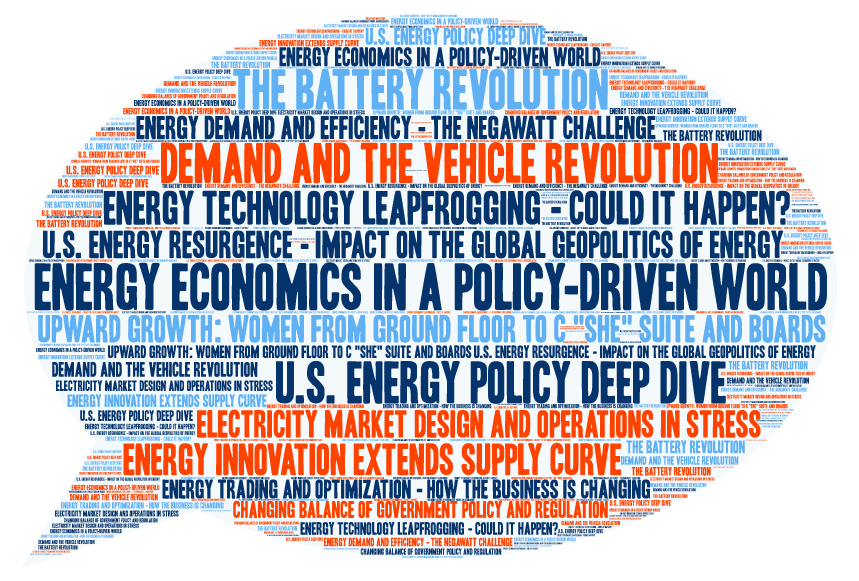Remember to Vote - Voting Is Open for the NCAC 2018-2019 Board NCAC Members
You should have received an email for the election of the 2018-2019 NCAC Council.
Only current members can vote. Please make sure your dues are up to date if you plan to vote. Visit the website and make a payment online.
Next Luncheon – June 8
And please make sure you are registered for the upcoming June 8 luncheon at Chinatown Gardens. The topic is Renewable Energy Entrepreneurship. The presenter will be Jason Levine, Chief Business Development Officer, CleanBay Renewables, with a very local perspective on helping clean up the Chesapeake Bay.
Energy – The Month Ahead
Michael Ratner, NCAC Vice President
Summer is here! In addition to summer pools opening and the school year ending, Washington will be abuzz with two big energy conferences. June 4-5 will be EIA's annual conference, which will feature Mark W. Menezes, the Under Secretary of DOE; Kevin McIntyre, Chairman of the Federal Energy Regulatory Commission; and Linda Capuano, the relatively new EIA Administrator. The two-day conference will cover all forms of energy supply and consumption. It will also include a special session on India's energy economy.
The EIA conference will be followed later in the month, June 25-29, by the World Gas Conference. This is a huge event, here in D.C. for the first time since the 1980s, and a great opportunity for the Washington energy community. The conference will feature over 600 speakers from around the world and a variety of companies. Both events highlight the importance of Washington, D.C. to global energy.
 National USAEE Conference Comes to D.C.!
National USAEE Conference Comes to D.C.!
USAEE is pleased to have an incredible lineup of speakers at the USAEE/IAEE North American conference, September 23-26, 2018, right here in Washington, D.C.
The 36th USAEE/IAEE Conference provides a forum for informed and collegial discussion of how the emerging realities will impact all stakeholders - from populations to companies to governments in North America and around the world.
We hope that you will join us in Washington D.C., as we highlight contemporary energy themes at the intersection of economics, public policy, and politics, including those affecting energy infrastructure, environmental regulation, markets vs. government intervention, and international energy trade.
Why Are Gasoline Prices Rising?
Alan H. Levine, Chairman, CEO, Powerhouse
U.S. motorists hit the road over the Memorial Day weekend, the unofficial beginning to the summer driving season, to find that retail gasoline prices were the highest since 2014 and some 22 percent above a year ago. The higher gasoline price came while American crude oil output was rising, breaking records last seen in 1970. The United States produced over ten million barrels of crude oil per day in 2017. And the U.S. government projects crude oil production reaching 11.3 million barrels daily by 2019.
This apparent contradiction - more feedstock for gasoline but higher prices for gasoline - reminds us that petroleum supply and price have always been and continue to be creatures of geopolitical tensions. Adequate supply is not enough to assure lower prices. OPEC, for example, adds to production despite the apparent agreement to restrain production for reduction of global supply. Any net OPEC loss really comes from production challenges in member states, particularly Venezuela, Algeria, Qatar and Iran.
Saudi Arabia has a reason to seek higher oil prices. The Kingdom is expected to offer shares of Saudi Aramco for public sale. The higher the oil price, the more attractive the shares of the first initial public offering (IPO) will be.
Changes in global demand can influence demand for feedstocks. The first quarter of 2018 was probably the strongest for global oil demand, year-on-year, since the fourth quarter of 2010. And recently expanded exports of petroleum, both crude oil and products, helps reduce supply here in the United States.
Oil Prices and Natural Gas Prices
David Givens, Head of Gas and Power Services, North America, Argus Media
Crude oil prices have climbed recently, encouraging U.S. exploration and production companies to drill more wells. Activity has increased in the Permian Basin as well as the Bakken and Eagle Ford shale plays, among other locations. Quantities of natural gas produced along with crude are likely to rise, which will probably keep gas prices in check during the storage injection season. Discounts to the Henry Hub have grown in southeastern New Mexico and West Texas, and bear watching in several other producing basins.
Leaders in Energy “Green Leaders for Local Impact” Retreat
Janine Finnell, President, Leaders in Energy
Our retreat is Friday, June 8th, from 1 - 5 pm at Potomac Overlook Regional Park, Arlington, VA.
This retreat is for those individuals seeking to take the next step in creating a positive impact at the community level in the DMV – creating actionable solutions that create more sustainable LOCAL communities. You may be a leader in your job, community, or just seeking to shape a better future. Won’t you step forward and be a part of creating solutions that matter for your local community?
We’ll examine several of the 17 United Nations Sustainable Development Goals (SDGs) including #7, (Affordable Clean Energy), #8 (Decent Work); and #9 (Resilience). These three goals will be explored, in addition to the larger SDG framework, as one of several approaches to share existing knowledge and allow new ideas to emerge and be jointly developed. We will examine how local leaders can translate larger global goals into action into their communities. Register at: https://leadersinenergy.org/green-leadership-retreat/
5th Annual Leaders in Energy Green Jobs Forum on “Growing the Regional Clean Economy.”
Thursday, August 16, 2018, 5 – 9 pm, at the Metropolitan Washington Council of Governments, Washington, D.C.
We will feature economic and business development officials from around the DMV region to hear their perspectives on trends in the clean energy and sustainability sectors. Our event will also provide an opportunity for job seekers to meet with companies who are hiring and educators who offer green career credentialing and training programs. Our event venue will be the Washington Metropolitan Council of Governments located at 777 North Capitol St, NE, Washington, D.C. 20002. Register at: https://leadersinenergy.org/green-jobs-forum-2018/
Offshore Wind Takes Off in the U.S.
Dr. Deniz Ozkan, Director of Analysis, Research and Systems Engineering, Atlantic Grid Development LLC
After a long delay, the U.S. is finally ready to jump-start the offshore wind industry on this side of the Atlantic. On May 23rd, after a competitive solicitation, Massachusetts’ utilities selected the first offshore wind project with which to negotiate a power purchase agreement — an 800 MW offshore wind farm that will be built 14 miles off Martha’s Vineyard by Vineyard Wind, a partnership between Copenhagen Infrastructure Partners and Avangrid.
On the same day, Rhode Island also announced that the state will support a 400 MW offshore wind farm that will be built by Deepwater Wind, a firm that owns and operates the first U.S. project, a 30 MW wind farm 4 miles off Block Island. These two projects are planned to be in operation between 2021 and 2023.
Since 2017, the Northeast Atlantic States have set ambitious offshore wind targets. In total, more than 8 GW of installed capacity is targeted by 2030, including 1600 MW in Massachusetts, 2400 MW in New York, 3500 MW in New Jersey and around 1000 MW in Rhode Island and Connecticut.
In addition, Maryland agreed to pay $131.9 per MWh in 2017 for 368 MW of wind divided between two projects located off the coast of Ocean City. They are expected to be in operation between 2020 and 2022.
Generating electricity from offshore wind is still relatively more expensive than natural gas generation. However, the trend in offshore wind costs is encouraging. By the end of 2017, Europe’s installed capacity reached 15.8 GW across 11 countries. In that record-breaking year, more than 3 GW of capacity was added.
And more notable than that, in April 2017, Germany awarded zero-subsidy contracts to three projects for 1.4 GW of total capacity. Also, in December 2017, the Netherlands received three competing zero-subsidy bids for the Hollande Kust Zuid offshore wind project. Technical advancements that create economies of scale and smart planning, including utility-designed and provided transmission systems, are the major drivers of recent cost reductions. In Europe, the price of offshore wind has fallen approximately 50% since 2012 and the industry’s 2020 target of €100/MWh was achieved several years early.
Offshore wind has huge potential, not just to become a major renewable resource in the coastal states here in the U.S., but also to create thousands of well-paying, long-term jobs. The transformation of former shipping industry assets such as vacant ports and other coastal brownfields, and the adaptation of offshore oil and gas industry know-how to offshore wind would add much needed local U.S. supply chain resources to the existing predominantly European capabilities. It would also help the U.S. design and optimize its offshore wind industry to match local needs and requirements.
Considering all the recent progress and the large goals of the U.S. offshore wind industry, it is not unreasonable to expect that offshore wind costs will be reduced below $100 per MWh very soon, and that a trend of continued cost reduction will make offshore wind a competitive resource someday. It is an exciting moment to be in the U.S. offshore wind business.
Atlantic Grid Development LLC is a developer of electric transmission systems for offshore wind.

 Sieminski: On the Move
Sieminski: On the Move
Adam Sieminski is the new President of The King Abdullah Petroleum Studies and Research Center (KAPSARC) located in Riyadh, Saudi Arabia. KAPSARC was founded in 2008 as an independent research institution to advance the understanding of energy and the economy.
KAPSARC’s mission is to promote dialogue locally and globally on how societies use energy. Adam is responsible for overseeing the day-to-day management of the institution, as well as well as providing strategic leadership to all research programs. He is working to emphasize the cooperation of KAPSARC’s employees, advisors, partners, and supporters in examining the most effective and productive applications of energy to enable economic and social progress in Saudi Arabia, the Gulf region, and across the world.
####